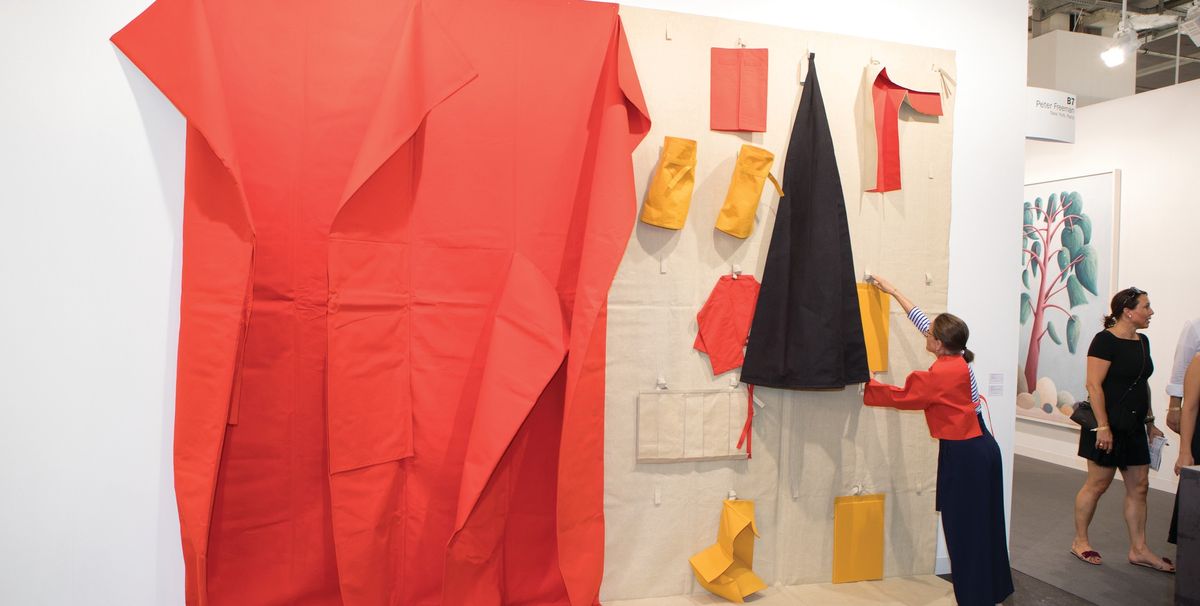By the close of play on Wednesday, dealers were tired but happy, reporting that the first wave of VIP collectors—many of them fresh off the Venice-Kassel-Münster circuit—had arrived engaged and prepared to spend handsomely. Hauser & Wirth declared Tuesday its most successful first day ever at Art Basel, having placed a 1970 oil by Philip Guston for $15m and an untitled painting by Eva Hesse with a Chinese museum for $2.5m, among a dozen early sales. Acquavella Galleries speedily unloaded a large Basquiat from the key year of 1982 for an asking price of $18m. Lévy Gorvy sealed the deal on a Sigmar Polke (lauded by the Polke aficionado Alexander Rotter of Christie’s as “spectacular”) for $12m yesterday.
Although the rebound of eight-figure sales in a fair context is notable, activity was hardly limited to the top end. “We could have sold this five times over,” says Susanne Vielmetter of a domestic-sized version of Andrea Bowers’s cardboard protest-sign collages, which was quickly snapped up by a collector on Tuesday for $65,000. Tom Dingle, a senior director at Thomas Dane gallery, who sold a painting by Marisa Merz from his all-female stand for $350,000, says: “Collectors here can be looking to spend at different levels from, say, $20,000 to $450,000.”
Any difficulty the auction houses have had over the past year in sourcing consignments was reflected inversely in the array of top-tier secondary material on offer at Art Basel. But the sales outlook was a bit more mixed for what the Galerie St Etienne co-director Jane Kallir termed “classical Modernism” of the German Expressionist variety. “I find it’s off to a slower start,” she says. “We’ve sold a number of things at lower price points, but people are not going to impulse-buy a $1m painting.” “It is quiet,” says Gilbert Lloyd of Marlborough, “but the jets are still landing.”
Many dealers were profiting from their artists’ visibility this spring. Daniel Buchholz had sold several abstract C-prints by Wolfgang Tillmans, whose Tate Modern show has just closed and whose retrospective at the Fondation Beyeler has just opened, at €60,000 apiece, as well as a painting by Anne Imhof featuring the artist Eliza Douglas menaced by a Molotov cocktail (à la Faust, her Venice Golden Lion-winning performance piece), acquired by a New York-based collector for €55,000. Peter Freeman, which represents Franz Erhard Walther, placed an important 1980s interactive fabric wall piece that the director Jayne Johnson described as “like relational aesthetics before that existed”.
Works recontextualised from artists’ estates proved catnip to buyers in search of a bankable discovery. An unusual joint exhibition of works by Hans Hartung—co-presented by Perrotin and Simon Lee—was met with enthusiasm, according to Perrotin’s Matthew Wilkin, while another solo-artist presentation, of intriguingly spare late works by Milton Avery at Victoria Miro, resulted in early sales. So, too, for established conceptual and abstract artists better known on one side of the Atlantic or the other. Dorsey Waxter, of Van Doren Waxter, who is introducing canvases by the late US painter Harvey Quaytman to a European audience, says: “There’s definitely a curiosity around geometric abstraction.”
Perhaps the strongest measure of the depth of the current market is the attention paid to lesser-known names of the 20th century who are being reappraised. In the Feature section devoted to solo presentations of older artists, Parrasch Heijnen is presenting sculptures and drawings by the nonagenarian artist Tony DeLap, whose work is being reappraised as an inspiration to his students, including Bruce Nauman and John McCracken. DeLap’s 1960s sculptures, with elements of Minimalism, Op Art and Finish Fetish, were on hold for museums in the range of $40,000 to $50,000.
“His influence is dramatic even though people don’t know his name,” Franklin Parrasch says. Similarly, cibachrome prints by the sculptor-photographer Barbara Kasten (to whom Tillmans has acknowledged a debt) on display at Kadel Willborn got “a very good response from artists as well as collectors”, Moritz Willborn says. Half of these New York City Constructs, made between 1982 and 1986, had been placed on hold, at prices ranging from $15,000 to $40,000.
“The market is very strong, but there’s no question that there’s uncertainty,” says Nicholas Acquavella of Acquavella Galleries. Still, given the imperative for freshness and quality that the Basel audience demands, “You’d have to have a pretty rough external environment to not have a solid fair,” he says.


